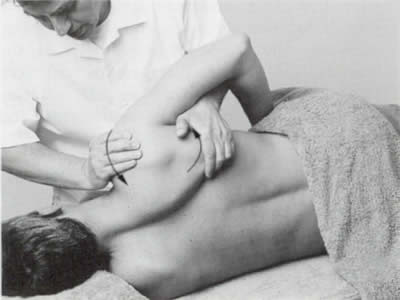Positive Health Online
Your Country

The Importance of Good Posture in Bodywork Part III
by Mario-Paul Cassar(more info)
listed in bodywork, originally published in issue 117 - November 2005
In Part 3 of this article on the importance of posture in massage and bodywork, I am going to consider the benefits and indications of carrying out a treatment with the patient side-lying or sitting.
Traditionally, massage and bodywork treatments are carried out with the patient lying prone or supine. In a way, this is understandable because the postural muscles are in a state of minimal contraction in these positions and the whole body is therefore encouraged to 'flop' and totally relax. There are occasions, however, when the patient is unable to lie prone for reasons such as injury, pregnancy, obesity, physical handicap or old age. Indeed, placing the patient in supine or prone on the treatment couch can at times be contra-indicated.
Lying prone, for example, is likely to be very uncomfortable in the case of a person who is overweight. In this position the lungs, abdominal viscera and diaphragm are compressed, and breathing becomes very strenuous. If the patient suffers from a heart condition or high blood pressure, the prone position can be even more awkward. The difficulty with breathing can easily put an additional stress on the heart and raise the blood pressure, sometimes indicated by a very red face. Emphysema is another condition when the patient cannot, and of course should not, be expected to lie down supine let alone prone.
Lying prone would also not be indicated for a patient who has pronounced lordosis, as the spine tends to go into extension and this can lead to compression of the vertebral joints. Conditions such as sciatica may also be exacerbated when the patient is lying prone. This position is similarly contra-indicated where there are weaknesses or situations relating to the abdomen, such as premenstrual tension, ulcers and most certainly in pregnancy
Elderly people may not be able to get on and off the treatment couch easily, perhaps due to an arthritic condition. Whilst lying supine may be a possible solution it may also be necessary and advisable to carry out the treatment with the patient in a sitting position. A patient who is physically disabled, perhaps in a wheelchair, can also find it strenuous to manoeuvre themselves on and off the couch. In such a situation treatment can be carried out with the person sitting.
It is important for the practitioner, especially the massage and bodywork graduate, not to be disheartened and wrongly assume that they cannot carry out a treatment if the patient is unable to lie down, or if they cannot lie prone or supine. It is equally essential that patients are informed that treatment is practicable even if they cannot recline easily. Carrying out a treatment with the patient side-lying or sitting can also be helpful for the practitioner. In some cases there could be a greater ease of posture and effectiveness of the treatment. Comfort and safety of the patient are vital. Therefore, all the necessary precautions are taken, and to this end the use of cushions, bolsters and towels is recommended.
A number of safe and variable arrangements can be used. For example, the patient can sit at one end of the treatment table. This is particularly good for elderly patients and ideally suited for massage and bodywork movements to the back and neck (Figure 1).

Effleurage to the back is carried out across the back, in a circular fashion or in a cephalad direction.
When this posture is used, the practitioner takes up a position to the side of the treatment couch and stands very close to the patient. He or she can then place one arm across the patient's upper chest and reach across to hold and stabilize the opposite shoulder. Further support is given by allowing the patient to lean against the practitioner's torso.
When in a side-lying position, most regions of the body can be treated, even the abdomen, and nearly all of the massage and bodywork movements can be carried out. Bodywork movements such as mobilization of the scapula are easier to carry out whilst the patient is in the side-lying position (Figure 2).

The scapula is mobilized with a rotational movement in one direction
The patient can sit on a chair close to the treatment couch or to a table; for instance when the patient is elderly and perhaps arthritic, or physically handicapped. This position can be also adapted if the patient is in a wheelchair. Cushions are used to support and offer comfort. Massage and bodywork treatment to the back can be carried out. This position is also ideally suited for massage to the arms (Figure 3).

Effleurage on the upper arm
Comments:
-
No Article Comments available